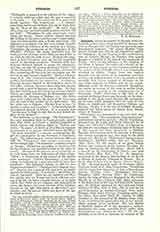

Synnada, titular metropolis in Phrygia Salutaris. Synnada is said to have been founded by Acamas who went to Phrygia after the Trojan war and took some Macedonian colonists. The consul Manlius Vulso passed through that city on his expeditions against the Galatians. It was situated in the southeastern part of Eastern Phrygia, or Parorea, thus named because it extended to the foot of the mountains of Pisidia. After having belonged to the kingdom of the Attali, it became the capital of a district of the province of Asia, except on two occasions during the last century of the Republic when it was temporarily attached to Cilicia. Under these two regimes Synnada was the center of an important conventus juridicus, or judicial center; it was to preside at this assembly that Cicero stopped at Synnada on his way from Ephesus to Cilicia and on his return. Although small, the city was celebrated throughout the empire on account of the trade in marble which came from the quarries of the neighboring city of Dacimium. Under Diocletian at the time of the creation of Phrygia Pacatiana, Synnada, at the intersection of two great roads, became the metropolis. On its coins, which disappear after the reign of Gallienus, its inhabitants call themselves Dorians and Ionians. Today it is the city of Schifout Kassaba, situated five hours south of Afioun Kara Hissar, vilayet of Broussa.
Christianity was introduced at an early date into Synnada. The “Martyrologium Hieronymianum” mentions several of its martyrs. For St. Trophimus, honored by the Latin and Greek Churches on September 19, see “Acta SS.”, VI September, 9 sq. A reliquary in the form of a sarcophagus containing some of the bones of this martyr has been discovered at Schifout Kassaba and transported to the museum at Broussa; this curious monument may date back to the third century [see Mendel in “Bulletin de Correspondance Hellenique”, XXXIII (1909), 342 sq.]. Eusebius (Hist. Eccl., VI, 19) speaks of its pious bishop Atticus who entrusted to the layman Theodore the duty of instructing the Christians. About 230-5 a council on the rebaptizing of heretics was held there (Euseb., Hist. Eccl;, VII, 7). St. Agapetus, mentioned in the Roman Martyrology on March 24 as Bishop of Synnada, belonged to Synaus. For a list of other bishops see Le Quien, “Oriens Christ.”, I, 827. Mention must be made of Procopius (321); Cyriacus, friend of St. John Chrysostom; Theodosius and his competitor Agapetus, at first a Macedonian heretic; Severus (431); Marinianus (448-51); Theogenes (536); Severus (553); St. Pausicacus, during the reign of Maurice, honored by the Greek Church on May 13; Cosmas, 680; John, adversary of the Iconoclasts in the time of Patriarch St. Germanus; St. Michael, honored by the Latin and Greek churches May 23, died May 23, 826, in exile for his zeal in defending the worship of images; Peter under Photius; John under Photius; Pantaleon under Leo the Wise; Leo under Basil II; Nicetas in 1082; Georgios at the Council of St. Sophia, about 1450, if one can believe the apocryphal Acts of this council, which perhaps never occurred. The last Bishop of Synnada spoken of in the documents, without mentioning his name, probably lived under John Cantacuzenus (see “Cantacuz. Hist.”, III, 73) and probably never lived at Synnada on account of the Turkish conquest. Several years after (1385) the see was committed to the Metropolitan of Philadelphia. In conclusion may be mentioned St. Constantine, a converted Jew of Synnada, who lived in the tenth century; he became a monk, and is honored by the Greek Church December 26.
S. P IRIDES

